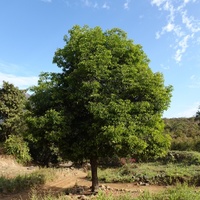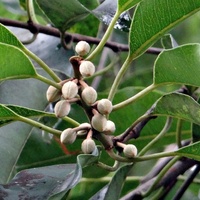Common name: Medlar
Other common names: Bullet wood, Indian medlar, Kabiki, Mamajen, Mimusops, Red coondoo, Pogada, Spanish cherry
Description
Medlar or Indian medlar is a landscape, hardwood timber, and essential-oil yielding tree native to a wide geographic area, extending from India, through Sri Lanka and Southeast Asia, to northern Australia.
In native forests, in the wetter parts of its range, it may attain a height of up to 30 m (100 ft). However, in the drier parts and out in the open, it is typically 10 to 15 m (30 to 50 ft) tall with a straight, low-branching trunk supporting a densely leafy, neatly shaped crown. The bark is dark grey or reddish-brown, smooth on young trees, on older trees becoming cracked and rough.
Leaves are oval with wavy margins (though are flat-margined in the Australian variety), 6 to 10 cm (2.4 to 4 in) long, light green when young becoming dark glossy green. They remain on the tree where the dry season is short but fall where it is long or pronounced.
Flowers are white, star-shaped, sweetly fragrant and showy but are part-hidden in the foliage. They bloom in the rainy season, with on and off blooms at other times, particularly in irrigated gardens and landscapes. Fertilised flowers develop into small egg-shaped fruit up to 3 cm (1.2 in) long. They are green when young, becoming orange when ripe, with mealy yellow pulp and one large seed inside, occasionally two.
Use
Medlar is a widely cultivated amenity tree in urban landscapes and parks in its native range, and where introduced, for its shapely form, densely leafy crown, shade and sweetly fragrant flowers. Its tolerance to salt spray also makes it a suitable tree for seaside plantings.
Medlar trees produce a medium-weight wood, averaging about 720 kgs per cubic meter (45 lbs per cubic ft), with moderate natural resistance to decay. This puts it in the moderately durable hardwood class, suitable for indoor and outdoor use. The heartwood is pink-red to red-brown, occasionally with dark streaks.
Well-formed logs are sawn into beams and planks used in heavy and light construction, including house-frame construction, flooring, decking, furniture, cabinets and interior joinery. Small diameter logs and branchwood are used for poles, posts, turnery and tool handles, and firewood and charcoal.
The flowers yield an essential oil extracted commercially by steam distillation, though in very small amounts of around 0.01% of the flowers by weight. It is a thin, light yellow liquid with a long-lasting floral aroma, described as reminiscent of orange blossom or gardenia and with a honey-like undertone. Its primary use is as a fragrance in Ittars, the traditional alcohol-free perfumes of India and the Middle East.
The fruit are edible, with a slightly sweetish but mealy or dry pulp and are considered a minor fruit with little to no commercial value.
The flowers attract honeybees, and it is reported as a honey plant in at least one reference publication. Still, reports on the quantity of nectar produced is conflicting. Otherwise, there is insufficient information to confirm it as an important bee forage or honey resource.
Health use
The fruit and seed are used in traditional Indian or Ayurvedic medicine. The ripe fruit pulp has astringent properties and is used to treat chronic dysentery. The seed is pounded into a paste then mixed with oil or butter for use as a suppository in cases of constipation in children.
Climate
Grows naturally in sub-humid to very humid tropical lowland climates, generally frost-free areas with annual lows of 18 to 25°C, annual highs of 27 to 36°C, annual rainfall of 700 to 4000 mm and a dry season of 8 months or less. However, it has its best development in areas with annual rainfall of 1500 mm or more and a winter dry season of 3 to 6 months.
Growing
New plants are usually started from seed, which lose their viability quickly and should be sown soon after extracting from the fruit. Seedlings can be planted out when around 30 cm (12 in) tall. They perform best on rich, free-draining loam and sand soils of a moderately acid to moderately alkaline nature, generally with a pH of 5.6 to 8.4, and on sites with full to partial sun exposure.
It has good tolerance to salt conditions and is somewhat tolerant to light shade but is intolerant of slow-draining or waterlogged soils.
Problem features
Large birds such as pigeons reportedly eat the fruit and disperse the seed. It is recorded as having naturalised in the Philippines. Still, there does not appear to be any records of it being a serious weed anywhere, despite its widespread introduction into regions outside of its natural range. It is assessed as a low weed risk species for Hawaii by the Hawaii Pacific Weed Risk Assessment (HPWRA) project.
Some litter is produced by the spent flowers, which fall and carpet the ground.
Where it grows
References
Books
-
Allen, B. M. 1967, Malayan fruits : an introduction to the cultivated species, Donald Moore Press, Singapore
-
Arctander, S. 1960, Perfume and flavor materials of natural origin, Elizabeth, New Jersey
-
Barwick, M., et al. 2004, Tropical & subtropical trees : a worldwide encyclopaedic guide, Thames and Hudson, London
-
Crane, E., Walker, P. & Day, R. 1984, Directory of important world honey sources, International Bee Research Association, London
-
Dey, S.C. 1996, Fragrant flowers for homes and gardens, trade and industry, Abhinav Publications, New Delhi, India
-
Krishen, P. 2006, Trees of Delhi : a field guide, Dorling Kindersley Publishers, Delhi
-
Lemmens, R.H.M.J., Louppe, D. & Oteng-Amoako, A.A. (eds). PROTA, Plant Resources of Tropical Africa, Volume 7(1) : Timbers 1, PROTA Foundation, Backhuys Publishers, Leiden
-
Macmillan, H. F. 1943, Tropical planting and gardening : with special reference to Ceylon, 5th ed, Macmillan Publishing, London
-
Martin, F. M., et al. 1987, Perennial edible fruits of the tropics : an inventory, U.S. Dept. of Agriculture (USDA), Agricultural Research Service, U.S. Government Printing Office (GPO), Washington, D.C.
-
McCann, C. 1959, 100 beautiful trees of India : a descriptive and pictorial handbook, [2d ed. rev. and enl.], D.B. Taraporevala, Bombay
-
Parrotta, J. A. 2001, Healing plants of peninsular India, CABI Publishing, Wallingford, Oxfordshire
-
Reyes, G. 1992, Wood densities of tropical tree species, U.S. Department of Agriculture, Forest Service, Southern Forest Experiment Station, New Orleans, Louisiana
-
Scheffer, T. C & Morrell, J. J. 1998, Natural durability of wood : a worldwide checklist of species, Forest Research Laboratory, Oregon State University, Corvallis, Oregon
-
Selvam, V. 2007, Trees and shrubs of the Maldives, Food and Agriculture Organisation (FAO) RAP publication (Maldives), Thammada Press Company Ltd., Bangkok
-
Streets, R. J. & Troup, R. S. 1962, Exotic forest trees in the British Commonwealth, Oxford University Press, Oxford, England
-
Troup, R.S. & Joshi, H. B. 1975 to 1981, Silviculture of Indian Trees (3 volumes), Government of India Publications, New Delhi
Articles, Journals, Reports and Working Papers
-
Morton, J.F. 1964, Honeybee Plants of South Florida, Proceedings of the Florida State Horticultural Society, Vol 77:415-436.


.5878.thumb.jpg)

